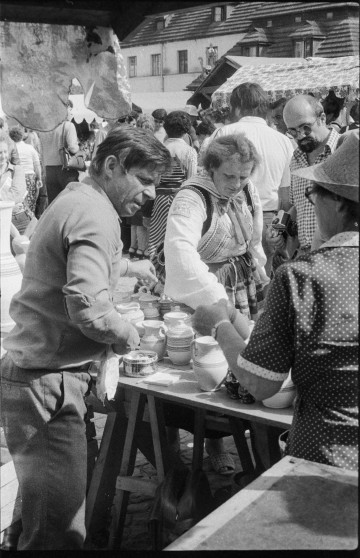
Kazimierz 1984: Folk Art Fair. Ceramics from Denkowo
1984
National Museum in Lublin
Part of the collection: Pyrzycka folk culture
Pottery covered with lead and tin glaze was fashionable in Pomerania from the 18th to mid 19th centuries. At that time, representatives of richer social classes started to prefer cheap porcelain, and the consumers of earthenware remained the inhabitants of villages and poor townsmen. At the beginning of the 20th century, the competition of cheap industrial products caused the production of expensive lead and tin-glazed earthenware to be discontinued. However, white glazed vessels were common in villages before it happened and were even called ‘peasant vessels’ (Bauerenfaynce). There were especially many of them in the prosperous region of Pyrzyce. They were made by numerous pottery workshops all over Pomerania. Surplus production was collected in Szczecin, where it was exported through the harbour to Scandinavia, and it also reached the Netherlands and England. There they were known as ‘Stettiner Ware’ (Szczecin's goods), ‘Pommerche Ware’ (Pomeranian goods), and in Sweden as ‘Stettiner fadee’ (Szczecin bowls).The presented pot has a typical shape: a convex body, wide spout surrounded by a collar and a massive banded ear. It is glazed on both sides and decorated with a simple stripe motif in a characteristic cobalt blue shade. It was used for storing and carrying ready-made dishes: soups, potatoes with sauce, etc. for people working in the field.
Iwona Karwowska
Author / creator
Dimensions
cały obiekt: height: 23,5 cm, diameter: 11 cm
Creation time / dating
Creation / finding place
Identification number
Location / status

1984
National Museum in Lublin

1984
National Museum in Lublin

1984
National Museum in Lublin
DISCOVER this TOPIC
National Museum in Lublin
DISCOVER this PATH
Educational path